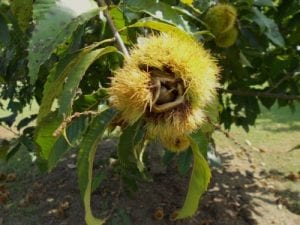
A quick update on our fall chestnut harvest season! We have added a second harvest event (see below)!
GA-TACF will hold several harvest events this fall, and would also like to solicit assistance from volunteers in our on-going search for American chestnuts in the wild. Harvest season generally starts in early September in low-lying/southerly areas and ends in early to mid-October in high elevation/northern areas of the state. We harvest nuts each fall to support our blight- and Phytophthora-resistance breeding programs, and to conserve genetic material from wild locations in nurseries and orchards.
Our first scheduled harvest at Berry College, from 10 am – 12 noon on Saturday Sept. 22. Berry College is just north of Rome on Rt. 27. Go through the main gate and stop by the Visitors’ Center. Ask for directions to the Old Mill. That is where we will meet at 10 am. This might be a useful training opportunity for those wishing to harvest burs in other locations.
Our second scheduled harvest is at Hickory Trails Park, 3884 Hickory Rd, Canton, GA 30115. This small park is east of Holly Springs and just west of Hickory Flat. GA-TACF members Joe Nicholson, Jim Bishop, Vince Payne, and Jonathan Price will be at the park starting at 4 pm on Saturday Sept. 29. These volunteers will direct the harvest and help other volunteers learn a bit about the blight and how to plant and care for a chestnut orchard. We are very interested in identifying a local stewardship group for this orchard, for which plans are underway for a re-planting.
BTW – if possible, bring leather gloves, pruning poles, a blunt knife (like and oyster knife), and ziplock bags to harvest events.
We will inform you of other scheduled harvest opportunities as they develop over the next several weeks. In most cases, you may take home some nuts from the harvest for eating!
To assist those interested in searching for wild American chestnuts on their own, we have produced this google map showing currently mapped trees in the state. Wild Tree Map (Click Here).
We are, however, equally interested in obtaining seeds from verifiable American chestnuts in other locations. For info on how to ID American chestnut, see https://tacf.org/resources/identification/ If the directions or comments for a particular mapped tree state that landowner permission is required, please contact us for more information about that tree and how to obtain access. Generally, state parks and wildlife management areas, and national forest areas are great locations to search for nut-bearing trees, and TACF has MOUs that allow such activities.
BTW – we are definitely not interested in seeds from Chinese chestnut (Castanea mollissima) at this time, only American chestnut (C. dentata). In any case, if you think you have found a nut-bearing American chestnut tree that is not on our map, please contact us at moc.liamg@tuntsehcag. We will help you verify its identity.
To harvest burs, it is best to use a telescoping pole pruner to pull down burs just as they start to brown up a bit and begin to open on their own. It is not advisable to pick up nuts from the ground, if the purpose is to plant the seeds. Allow the burs to dry for a day or two indoors in a paper bag or cardboard box, then carefully open the burs using a blunt instrument such as an oyster knife, and using good leather gloves. Viable seeds should be plump, brown, and fall easily from the burs as they are opened. Place them in a zip-lock bag in the fridge, and arrange to have them shipped to us via overnight mail (contact moc.liamg@tuntsehcag for address and directions). If you want to save some seeds to plant on your own, place some barely damp peat moss in the bag, punch a number of small holes in the bag, and keep in the crisper of your refrigerator. Check to see that the peat moss does not dry out too much over the winter. Seeds generally begin to germinate in the fridge by late January.
Thanks, and here’s hoping for a happy harvest!
Martin Cipollini, GA-TACF Science Coordinator
Please share!

